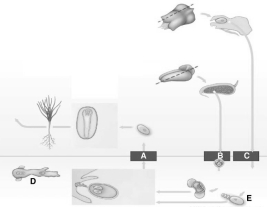A) conducts water up the plant
B) conducts mineral ions up the plant
C) connects with roots
D) connects with leaves
E) transports plant-manufactured organic products
G) A) and B)
Correct Answer

verified
Correct Answer
verified
Multiple Choice
Which of the following is NOT true concerning Pangaea?
A) It formed during the Permian.
B) Gymnosperms flourished on Pangaea
C) It caused climates to become warmer and wetter.
D) It began to break apart during the Jurassic.
E) Plant diversity expanded on its isolated fragments during and after the Jurassic.
G) D) and E)
Correct Answer

verified
Correct Answer
verified
Multiple Choice
In the above figure, which of the following would have a diploid number of chromosomes?
A) zygote
B) multicelled sporophyte
C) spores
D) multicelled gametophytes
E) both a and b
G) A) and B)
Correct Answer

verified
Correct Answer
verified
Multiple Choice
Which of the following is NOT a factor that contributed to the production of coal from the remains of Carboniferous vegetation?
A) heat
B) pressure
C) drying
D) decomposition
E) compaction
G) B) and C)
Correct Answer

verified
Correct Answer
verified
Multiple Choice
The life cycle of flowering plants includes
A) formation of pollen.
B) formation of eggs.
C) fertilization.
D) formation of seeds.
E) all of these.
G) C) and E)
Correct Answer

verified
Correct Answer
verified
Multiple Choice
Dependence on animal vectors for fertilization and dispersal is characteristic of many species of
A) ferns.
B) angiosperms.
C) mosses.
D) conifers.
E) cycads.
G) A) and D)
Correct Answer

verified
B
Correct Answer
verified
Multiple Choice
The evolution of __________ was crucial in the evolution of plants from aquatic to terrestrial environments.
A) roots
B) leaves
C) stems
D) stomata
E) all of these
G) A) and D)
Correct Answer

verified
Correct Answer
verified
Multiple Choice
The male gametophyte becomes
A) ovules.
B) seeds.
C) pollen grains.
D) cones.
E) sperm cells.
G) C) and D)
Correct Answer

verified
Correct Answer
verified
Multiple Choice
During the Carboniferous Period, the competitive edge was held by plants
A) with well-developed gametophytes.
B) with cuticles.
C) with lignin-reinforced tissues.
D) with underground stems.
E) that produced seeds.
G) B) and C)
Correct Answer

verified
Correct Answer
verified
Multiple Choice
Questions refer to the figure above.
 -Sperm swim from __________ to __________ for fertilization.
-Sperm swim from __________ to __________ for fertilization.
A) B; A
B) D; C
C) D; E
D) C; D
E) E; C
G) A) and E)
Correct Answer

verified
Correct Answer
verified
Multiple Choice
Which of the following is NOT true of gametophytes?
A) They are haploid plants.
B) They produce gametes.
C) They are the result of sexual reproduction.
D) They are a stage in the life cycle of plants.
E) Their gametes are either male or female.
G) C) and D)
Correct Answer

verified
C
Correct Answer
verified
Multiple Choice
Which of the following is NOT true concerning plants?
A) There are at least 295,000 kinds of existing plants.
B) Plants affect the composition of the atmosphere.
C) Flowering plants are the dominant group in most regions.
D) The colonization of the land by plants made it possible for animals to live and evolve on land.
E) Plants resupply atmospheric oxygen by splitting CO2 during photosynthesis.
G) A) and C)
Correct Answer

verified
Correct Answer
verified
Multiple Choice
The group of plants that has the most species is the
A) mosses.
B) ferns.
C) gymnosperms.
D) eudicots.
E) monocots.
G) A) and C)
Correct Answer

verified
Correct Answer
verified
Multiple Choice
Questions refer to the figure of the life cycle of a pine above.
 -The male gametophyte is indicated by
-The male gametophyte is indicated by
A) A.
B) B.
C) C.
D) D.
E) E.
G) C) and D)
Correct Answer

verified
Correct Answer
verified
Multiple Choice
Which of the following are NOT seed-bearing plants?
A) cycads
B) ferns
C) ginkgos
D) angiosperms
E) conifers
G) B) and D)
Correct Answer

verified
Correct Answer
verified
Multiple Choice
Coal is
A) a nonrenewable resource
B) a fossil fuel
C) rich in stored carbon energy
D) organic remains of ancient seedless plants
E) all of the above are true
G) C) and D)
Correct Answer

verified
Correct Answer
verified
Multiple Choice
Which of the following statements about pinecones is true?
A) Cones are exclusively female structures.
B) Cones are the result of pollination.
C) One type of cone produces microspores.
D) Pollen grains are retained within male cones.
E) Microspores develop into female gametophytes within the ovule.
G) C) and E)
Correct Answer

verified
C
Correct Answer
verified
Multiple Choice
The "leaves" of ferns are known as
A) rhizomes.
B) rhizoids.
C) fronds.
D) sori.
E) none of these.
G) B) and C)
Correct Answer

verified
Correct Answer
verified
Multiple Choice
Prior to 500 million years ago, organisms were unable to venture onto land because
A) the earth's crust was too hot.
B) the land was too dry.
C) there was not enough oxygen in the atmosphere for respiration.
D) the land was not shielded from the sun's ultraviolet radiation.
E) there was no organic matter on land for food.
G) All of the above
Correct Answer

verified
Correct Answer
verified
Multiple Choice
Which of the following statements concerning fertilization in ferns is true?
A) It occurs outside the egg-producing structure.
B) It requires water.
C) The fertilization product is haploid.
D) A spore is the product of fertilization.
E) None of these are true.
G) B) and D)
Correct Answer

verified
Correct Answer
verified
Showing 1 - 20 of 67
Related Exams